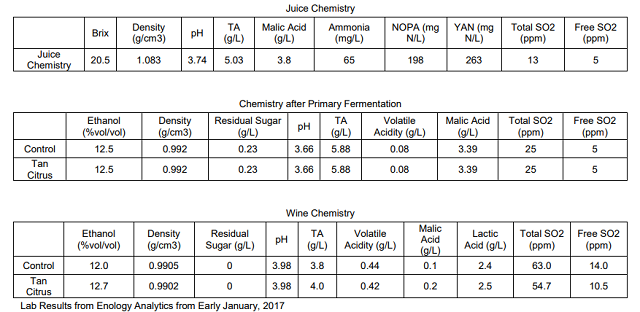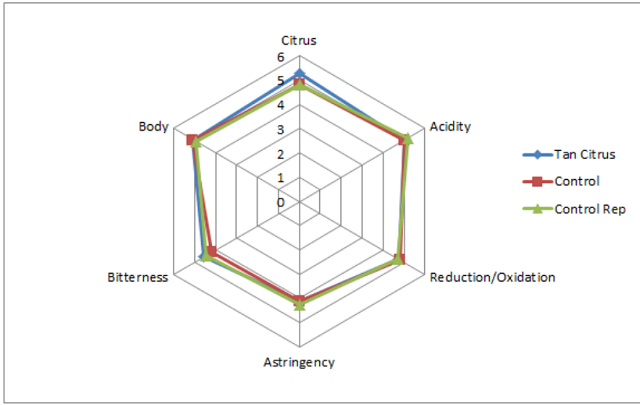The Effect of Tan Citrus on Chardonnay (2016)
Emily Pelton
Veritas Vineyards and Winery
Summary
This study compares Chardonnay wine fermented either with or without the enological tannin Tan Citrus (Enartis) added before primary fermentation. When combined with yeast with β-glycosidic activity, this tannin may increase fruit and floral aromas in wine. The yeast used in this study was CY3079. No major chemical differences were found between wines. The wines were not significantly different. There was a very slight preference for the wine made with Tan Citrus. More work is needed on the enological additive to effectively evaluate its impact.
Introduction
Enartis Tan Citrus is a fermentation tannin which is extracted to preserve naturally occurring aromatic compounds in the wood such as norisoprenoids and terpenes. In general, fermentation tannins are supposed to help protect wines against oxidation. This tannin, when used in combination with a β-glycosidic yeast, may enhance aromas of white and rosé wines (due to these aromatic precursors being glycosidically bound) (Enartis 2011). This study compares Chardonnay wine fermented either with or without the enological tannin Tan Citrus added before primary fermentation. The yeast used in this study was CY3079, a yeast with low glycosidic activity.
Results and Discussion
No major chemical differences were found between wines, except that the wine made with Tan Citrus had a slightly higher alcohol content. This is not likely due to the Tan Citrus, however.

Of 37 people who answered the triangle test, 14 people chose the correct wine (38%), meaning that the wines were not significant different. In general, people who answered correctly preferred the Tan Citrus treatment to the control.

No significant differences were found between wines for the descriptors used; however, the wine with Tan Citrus tended to show slightly higher citrus scores despite not being made with a glycosidic yeast.

The results of this study were likely lessened in impact from neglecting to use a glycosidic yeast. However, it is interesting to note that of the people who were able to discern differences, the wine made with Tan Citrus was preferred. More work is needed on this fermentation tannin to adequately gauge its impact.
Methods
Chardonnay was harvested on 9/21 and refrigerated overnight. Grapes were pressed on 9/22 on Europress Champagne cycle, with 35ppm sulfur dioxide added. 24 hours later, 1.6mL/hL Cinn Free was added, and juice was cold settled at 45°F. On 9/25 juice was racked and transferred to barrels. On 9/26, barrels were inoculated with CY3079 at 20g/hL rehydrated with FermoPlus Energy GLU. At this stage 7g/hL of Enartis Tan Citrus was added to one barrel. Although Tan Citrus is advertised as being most effective when used in combination with a yeast with high β-glycosidic activity, CY3079 does not have high β-glycosidic activity and as such the Tan Citrus may not have been fully activated. On 9/28 10g/L sugar and 0.5g/L tartaric acid was added. On 10/13 alcoholic fermentation was complete, and on 10/17 PreAC450 malolactic bacteria was inoculated at 1g/hL. Bâtonnage was performed weekly from 10/25-11/29. On 12/8 MLF was complete and wine was stabilized with 30ppm sulfur dioxide and samples were taken. This wine was tasted on January 25, 2017 at Early Mountain Vineyards.
For the triangle test and preference analysis, anybody who did not answer the form were removed from consideration for both triangle, degree of difference, and preference analysis. Additionally, anybody who answered the triangle test incorrectly were removed from consideration for degree of difference and preference. Any data points for preference which did not make sense (such as a person ranking a wine and its replicate at most and least preferred, when they correctly guessed the odd wine) were removed.
For descriptive analysis, any judge that did not completely rank the wines were removed from the data set. Then, one judge was randomly moved from Group 2 to Group 3 to balance the data set. All judges were divided into 3 groups, each with 10 judges. For statistical purposes, judges were considered replicates and groups were considered judges. Data was analyzed using PanelCheck software V1.4.2. Because this is not a truly statistical set-up, any results which are found to be statistically significant (p<0.05) will be denoted as a “strong trend” or a “strong tendency,” as opposed to general trends or tendencies. The statistical significance here will ignore any other significant effects or interactions which may confound the results (such as a statistically significant interaction of Judge x Wine confounding a significant result from Wine alone). The descriptors used in this study were Citrus, Acidity, Reduction/Oxidation (as a scale from most reduced to most oxidized), Astringency, Bitterness, and Body.
References
Enartis. 2011. Enartis Tan Citrus: Blend of enological tannins specifically intended for protection against oxidation and increased fruit aromas of white and rosé wines. shop-usa.enartis.com/amfilerating/file/download/file_id/7. Accessed 5/9/2017.
